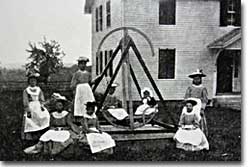Shakers
England, USA
Religious, Christian
Celibate
Communal Property
1174 - Present
![]()
England, USA
Religious, Christian
Celibate
Communal Property
1174 - Present

1 Meeting Room / Chapel 2 Sister Stair Hall 3 Deaconess Room 4 Deacons Room 5 Brothers Stair Hall 6 Brothers Room 7 Elder Brothers’ Room 8 Elder Sister’s Room 9 Sister’s Room
![1933 Main Residence, New Lebanon. Plan: Drawn from Historic American Buildings Survey 1933, Library of Congress]()
The United Society of Believers in Christ’s Second Appearing was founded by Sister Ann Lee in 1700. Named for their ecstatic dance, characterized by fits of shaking, the “Shaking Quakers” believed that Christ’s second coming had already occurred and they were living in the new Millennium. The group’s celibacy and communalism arose from the belief that there was no marriage or private property in heaven. Perfection, Order, Purity, and Plainness were the dictates of the Shaker faith, and there were rules for everything; how to dress, walk, speak, and behave at the table. Their values were reflected in the utility, function, and austere beauty of their inventions, furniture, and buildings. Their ingeneouos inventions, including the circular saw and the wheel-driven washing machine, were never patented–the first open source technology. The combination of religious inspirations and a skillful workmanship produced beautiful, functional objects.
“Odd or fanciful styles of architecture may not be used among the Believers,” and buildings reflected and enforced Shaker ideals. Men and women lived under the same roof in this celibate society–the symmetrical organization reflected the separate but equal society. The arrangement of rooms, doors, and staircases meant there was almost no privacy or freedom of movement. In the 18th and 18th century, the Shakers did a boom conversion business but their population at the time of writing in 2022, is two.

The United Society of Believers in Christ’s Second Appearing was founded by Sister Ann Lee in 1700. Named for their ecstatic dance, characterized by fits of shaking, the “Shaking Quakers” believed that Christ’s second coming had already occurred and they were living in the new Millennium. The group’s celibacy and communalism arose from the belief that there was no marriage or private property in heaven. Perfection, Order, Purity, and Plainness were the dictates of the Shaker faith, and there were rules for everything; how to dress, walk, speak, and behave at the table. Their values were reflected in the utility, function, and austere beauty of their inventions, furniture, and buildings. Their ingeneouos inventions, including the circular saw and the wheel-driven washing machine, were never patented–the first open source technology. The combination of religious inspirations and a skillful workmanship produced beautiful, functional objects.
“Odd or fanciful styles of architecture may not be used among the Believers,” and buildings reflected and enforced Shaker ideals. Men and women lived under the same roof in this celibate society–the symmetrical organization reflected the separate but equal society. The arrangement of rooms, doors, and staircases meant there was almost no privacy or freedom of movement. In the 18th and 18th century, the Shakers did a boom conversion business but their population at the time of writing in 2022, is two.








Shakers End Notes
Ray, Mary Lyn. “A Reappraisal of Shaker Furniture and Society.” Winterthur Portfolio 8 (1973): 107–32. http://www.jstor.org/stable/1180548.
Nicoletta, Julie. “The Architecture of Control: Shaker Dwelling Houses and the Reform Movement in Early-Nineteenth-Century America.” Journal of the Society of Architectural Historians 62, no. 3 (2003): 352–87. https://doi.org/10.2307/3592519.